For those who enjoy Japanese flavors, you have to try this. The Wagyu beef melts in the mouth, and its flavor is enhanced by the sweetness and soy sauce.
Forget fancy restaurants and complicated dishes. Sometimes, the most comforting meals are the ones born from simplicity and necessity. Enter gyudon, a beloved Japanese classic that has fueled generations. It's said to have originated as a quick, affordable meal for students and laborers – those needing a hot, satisfying dish to power them through long days.
Picture this: tender slices of beef, simmering in a savory-sweet sauce with just a hint of onion. The aroma alone is enough to make your stomach rumble. Served over fluffy white rice, it melts in your mouth. There's a reason gyudon is called comfort food; it's like a warm hug in a bowl, reminding you that even the simplest things can bring the deepest satisfaction.
This classic bowl of beef and rice has a story as rich and satisfying as its flavors. Originating in the late 19th century, Gyudon quickly became a staple for busy city dwellers and students looking for a quick, hearty, and affordable meal. Its simplicity and depth of flavor have made it a beloved dish across generations.
JUMP TO:
INGREDIENTS:
Marbling is essential: Gyudon is all about rich, melt-in-your-mouth beef, so look for wagyu with excellent marbling (those beautiful streaks of fat). A higher grade like A4 or A5 will provide incredible tenderness. Ideally, ask your butcher for shaved wagyu specifically for gyudon. If that's unavailable, thinly slice a cut like ribeye or short rib against the grain yourself.
Beef: If Wagyu beef is unavailable or too expensive, other thinly sliced beef cuts like sirloin or ribeye can be used. For a leaner option, use round or flank steak.
Onion: Sweetness over pungency. While any onion technically works, yellow onions offer the best sweetness for gyudon. Their sugars caramelize beautifully, complementing the sauce. Avoid red onions as they can be overly pungent.
Onion Slicing technique: Cut the onion thinly, against the grain. This ensures the onion cooks down into the sauce, contributing flavor without harsh texture.
Understanding Sake's Role: Sake adds umami depth to the sauce, while its subtle sweetness balances the soy sauce. It also contains enzymes that help tenderize the beef. Steer clear of "cooking sake" which often contains added salt and other ingredients. Look for "junmai-shu" which signifies pure rice sake.
Sake: If you don't have sake or prefer not to use it, you can substitute it with a non-alcoholic option like apple juice or just increase the water slightly. In a pinch, a dry white wine mixed with a touch of rice vinegar can partially mimic sake's flavor profile.
Soy Sauce: A low-sodium soy sauce can be used for a healthier option or tamari for a gluten-free alternative.
Sugar: Sugar in Gyudon isn't just for sweetness; it balances the savory notes of soy sauce and the acidity of sake and Mirin. Use a fine granulated sugar for quick dissolving. If looking for a subtler sweetness, consider honey or agave syrup, but be mindful of their distinct flavors. Brown sugar can be used instead of regular sugar for a deeper flavor.
Replacing the Beef: Replace the beef with thinly sliced mushrooms (like shiitake or portobello) or tofu for a vegetarian version. Adjust cooking times accordingly as these will cook faster than beef.
MAIN STEPS:
Precision in Beef Slicing: In preparing Gyudon, the thinness of the Wagyu beef slices is crucial. Thin slices not only ensure a quick cooking time but also allow the beef to absorb the flavors of the sauce more effectively. If slicing at home, ensure your knife is sharp and your technique steady for uniform thickness. Alternatively, requesting your butcher to slice the beef can guarantee consistency, especially if they're familiar with the requirements for Japanese cuisine.
Onion Slicing Technique: When slicing onions for Gyudon, aim for thin, even slices. This is important as thicker slices might not cook through properly or could dominate the texture of the dish. Thinner slices blend more harmoniously with the beef and absorb the sauce better, contributing to a balanced flavor profile.
Handling Red Ginger: While red ginger isn't listed in the ingredients, it's mentioned in the directions. If including red ginger (beni shoga), shredding it finely is key. This increases its surface area, allowing its distinctive flavor to permeate the dish more effectively, enhancing the overall taste experience.
Simmering Time for Beef: The recommendation to simmer the beef and onion in the sauce for 15-30 minutes is flexible, depending on the desired tenderness of the beef and the intensity of flavor. Longer simmering leads to more tender beef and a richer, more developed sauce, but there's a balance to strike – too long could make the beef overly soft.
SERVED WITH:
Appetizer: Miso Soup (Japan): A light and savory soup made with dashi (fish and kelp stock), miso paste (fermented soybean), and additions like tofu, seaweed, and green onions.
Side Dish: Tsukemono (Japan): Traditional Japanese pickles made with various vegetables like daikon radish, cucumbers, or cabbage. They offer a vibrant, tangy contrast to Gyudon.
Side Dish: Sunomono (Japan): A refreshing cucumber salad often seasoned with rice vinegar, soy sauce, a bit of sugar, and sometimes sesame seeds.
Side Dish: Edamame (Japan): Steamed or boiled young soybeans in the pod. A popular and simple snack or side.
Dessert: Mochi Ice Cream (Japan): Small, round balls of ice cream wrapped in a sweet, chewy rice dough (mochi). Flavors like green tea, mango, and strawberry are popular.
Dessert: Fruit Salad (Global): A light and refreshing dessert, perfect after a heavier dish like Gyudon.
Dessert: Dorayaki (Japan): Two small pancake-like patties made from castella with a sweet filling, usually red bean paste (anko).
Beverage: Green Tea (Japan): The classic pairing – green tea cuts through the richness of the Gyudon and cleanses the palate.
Beverage: Sake (Japan): This fermented rice beverage provides a smooth counterpoint to the savoriness of Gyudon. Can be served warm or chilled.
ALTERNATIVES:
Main Course: Beef Bulgogi (Korea): Thinly sliced beef marinated in a soy sauce, garlic, ginger, and sesame oil mixture, then grilled or stir-fried. Sweet, savory, and perfect over rice.
Main Course: Rouladen (Germany): Thin beef slices stuffed with onions, pickles, and bacon, then braised in a rich broth, creating an incredibly tender and flavorful dish.
Main Course: Carne Asada (Mexico): Skirt or flank steak marinated in citrus, garlic, and spices, then grilled and thinly sliced. Often served as tacos or in burritos, bringing a zesty kick to the Gyudon concept.
Main Course: Philly Cheesesteak (USA): Shaved beefsteak cooked with onions and often bell peppers, then piled onto a roll with melted cheese. A hearty and satisfying twist.
Main Course: French Onion Beef Sliders (France/USA): Sweet caramelized onions and tender beef simmered in broth, served on small buns with melty Gruyere cheese.
Main Course: Sukiyaki (Japan): A hot pot dish where thinly sliced beef, vegetables, and tofu are simmered in a sweet soy broth at the table. A more elaborate and communal variation on the gyudon theme.
Main Course: Beef Stroganoff (Russia): Tender strips of beef sautéed with onions and mushrooms in a creamy, sour cream-based sauce. A comforting classic that shares the savory richness of gyudon.
HISTORY:
Gyudon's origins lie in the transformative Meiji Era of Japan (1868-1912). Prior to this period, beef consumption was largely taboo due to Buddhist influences. However, as Japan opened up to the West, dietary habits shifted, paving the way for dishes like gyudon. Street vendors and small restaurants likely started serving simplified versions of an earlier hotpot dish known as "gyunabe." Seeking affordability and speed, they focused on the core ingredients of beef and onion, simmering them in a sweetened soy broth over rice.
While no single figure can be definitively credited as the inventor of gyudon, Eikichi Matsuda stands out. He established a restaurant called "Yoshinoya" (now a massive gyudon chain) in Tokyo's bustling fish market in 1899. Whether Matsuda was the true innovator or not, his establishment played a fundamental role in popularizing the dish. It's also possible that smaller, unknown establishments served similar fare around roughly the same time, contributing to the organic evolution of this iconic dish.
Efficiency was a cornerstone of gyudon's success. The hearty, savory-sweet bowl of rice and meat offered a quick and satisfying meal tailored to busy workers and students on a budget. As time passed, subtle regional preferences emerged. The Kanto region emphasized a more pronounced savory-sweet balance, while Kansai versions sometimes featured a lighter broth with a stronger dashi presence.
Japan's post-war economic surge saw the rise of chain restaurants, solidifying gyudon's national presence. Brands like Yoshinoya, Sukiya, and Matsuya became fixtures of Japanese life, making gyudon accessible to nearly everyone. It became synonymous with the hardworking Japanese salaryman, offering a fast and energizing meal. But beyond its practicality, gyudon also became a comfort food, evoking nostalgic, heartwarming feelings of "Japanese soul food" for many people.
The significance of gyudon even seeped into Japanese popular culture, with frequent appearances in manga and anime. This demonstrates its relatable, everyday connection to ordinary life. Today, gyudon endures as a testament to its timeless appeal, loved by all generations. While the core remains traditional, innovation finds its way through premium cuts of beef, spicy versions, and even gyudon curries! Gyudon's story is one of practicality, cultural significance, and delicious simplicity.
TIPS:
Slow Cooker: You can prepare the beef and onion mixture in a slow cooker, cooking on low for several hours until tender.
Pressure Cooker: For a quicker method, a pressure cooker can tenderize the beef in a shorter amount of time.
Brown the Beef First: Searing the beef before simmering creates a more complex flavor due to the Maillard reaction, developing caramelization.
Selecting the Right Beef: While Wagyu beef is a luxurious choice, you can also experiment with other cuts like thinly sliced ribeye or sirloin for different textures and flavors. The key is to use high-quality, marbled beef for the best results.
Beef Marination: Marinate the beef slices in a mixture of soy sauce, mirin, and sake for at least 30 minutes before cooking. This process infuses the meat with flavor and tenderizes it. Marination helps in breaking down the protein fibers, resulting in a more tender and flavorful beef.
Dashi Base: Instead of plain water, a simple dashi stock adds a savory umami depth to the sauce.
Egg Variations: A poached or soft-boiled egg on top adds richness. Onsen tamago (hot spring egg) is especially luxurious.
Garnishes: Finely sliced scallions add freshness, shichimi togarashi (Japanese spice blend) offers subtle heat.
Enhancing Aroma: Add a small piece of kombu (dried kelp) to the saucepan while simmering the beef. Remove it before serving. Kombu adds a subtle umami flavor that complements the beef and soy sauce mixture, enhancing the overall aroma and taste of the dish.
Recipe Information
Skill Level
|
Time 45 Minutes |
Price
|
Serves 1 to 8 People |
| Healthiness |
Nutritional Information |
| Ratings (Add Rating & Review) |
Reviews 8 Reviews |
Ingredients:
-
2.5 cups Wagyu Beef
2 cups Water
0.6 cup Soy Sauce
1 Onion
4 tablespoons Mirin
4 tablespoons Sake
2 tablespoons Sugar
Allergens
| Gluten | Soy | Sulphites |
Directions:
Preparing the Ingredients:
01 - Begin by thinly slicing the Wagyu Beef. If you're not comfortable slicing it yourself, you can ask your butcher to do this for you. The key is to get thin, even slices that will cook evenly.
02 - Next, take the Onions and slice them. You want to make sure your slices are not too thick so that they cook quickly and evenly along with the beef.
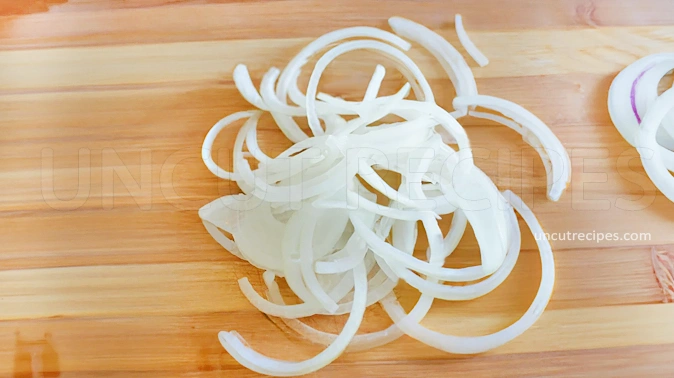
03 - Shred the Red Ginger. This can be done using a grater or a sharp knife. Shredding the ginger will help release its aromatic flavors more effectively into the dish.

04 - Now, cut the sliced Beef into bite-sized pieces. This makes the beef easier to eat and ensures that it cooks through evenly.
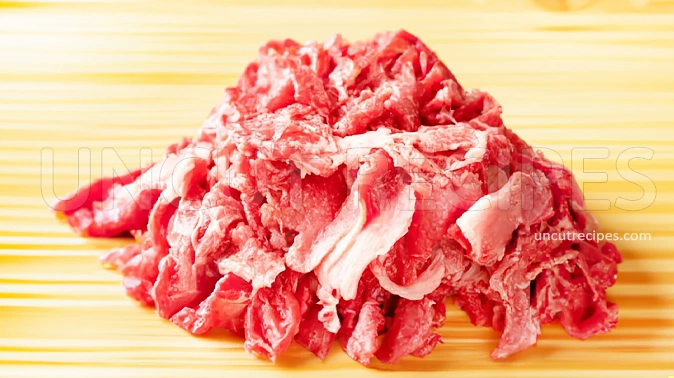
Cooking the Dish:
05 - In a saucepan, combine the Soy Sauce, Sake (which is optional, so you can leave it out if you prefer), Sugar, and Water. Bring this mixture to a boil and let it cook for about 3 minutes. This process will blend the flavors together.

06 - Add the sliced Onion and the bite-sized pieces of Beef to the saucepan. Stir everything together well, making sure the beef and onion are well-coated with the sauce.
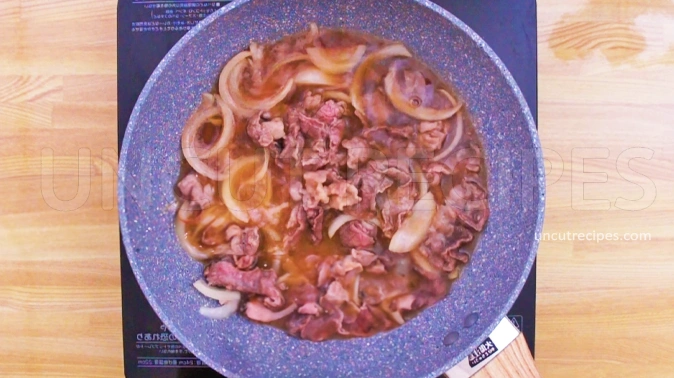
07 - Reduce the heat to a simmer and let the mixture cook for 15-30 minutes. This slow cooking process will tenderize the beef and infuse it with the flavors of the sauce.
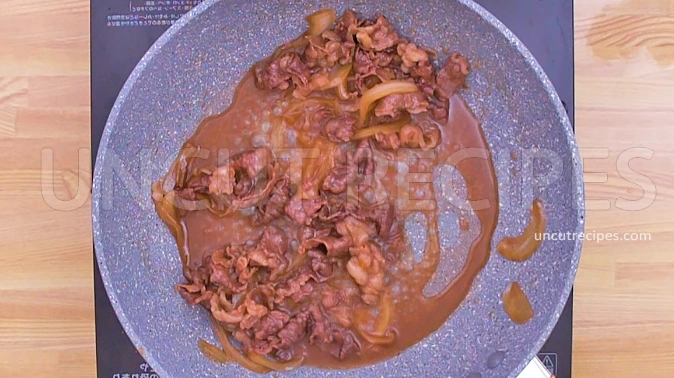
08 - Once the beef is cooked to your liking, it's time to assemble the dish. Place the beef and onion mixture on top of a bed of freshly cooked Rice. This will form the base of your dish.
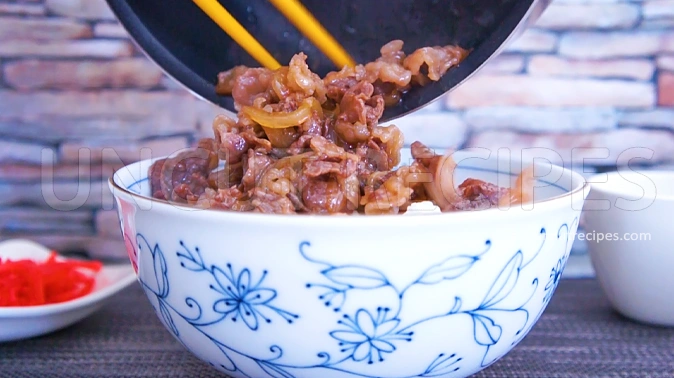
09 - Finally, sprinkle the shredded Ginger over the top of the beef and rice. The ginger adds a fresh, zesty flavor that complements the richness of the beef. Serve hot and enjoy your delicious meal!
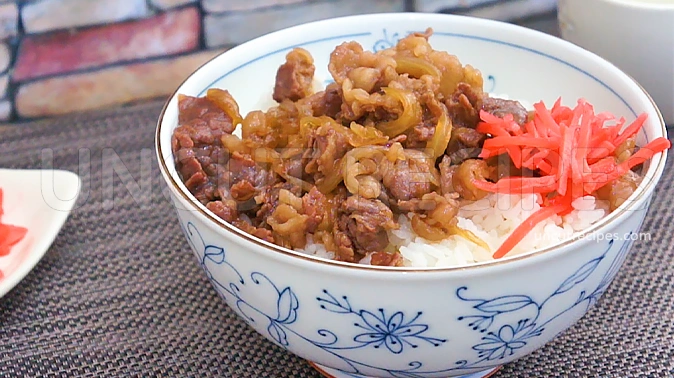
Notes:
Refrigeration: Store any leftovers in an airtight container in the refrigerator for up to 2-3 days.
Freezing: It's possible to freeze the beef and onion mixture for up to a month. However, for the best quality, consume within a few weeks. Thaw in the refrigerator before reheating.
Side Dishes: Serve with a side of pickled vegetables or a simple salad to balance the richness of the dish.
Toppings: Soft-boiled eggs or sesame seeds can be added as additional toppings.
Cooking Ahead of Time:
Beef and Onion Mixture: This can be cooked ahead of time and stored in the refrigerator. Reheat gently before serving over freshly cooked rice.
Beef Preparation: Freezing the beef slightly before slicing can make it easier to cut thin, even slices.
Rice: Using Japanese short-grain rice will provide an authentic texture and flavor for the dish.
Ginger: Fresh ginger is preferred for the best flavor, but pickled ginger can also be used as a topping.
Nutritional Information
( Per Portion )
|
Calories |
745 kcal (37%) |
| Total Carbohydrate | 102g (34%) |
| Cholesterol | 101mg (34%) |
|
Total Fat |
32g (53%) |
| Saturated Fat | 13g (62%) |
| Polyunsaturated Fat | 4g (24%) |
| Monounsaturated Fat | 12g (43%) |
| Trans Fat | 0g (0%) |
| Fibers | 2g (6%) |
| Protein | 43g (84%) |
| Sugar | 18g (72%) |
|
Vitamin A |
240 IU (30%) |
|
Vitamin B1 (Thiamin) |
0.4mg (35%) |
| Vitamin B2 (Riboflavin) | 0.3mg (25%) |
| Vitamin B3 (Niacin) | 5mg (31%) |
| Vitamin B5 (Pantothenic Acid) | 1mg (20%) |
| Vitamin B6 | 0.2mg (15%) |
| Vitamin B7 (Biotin) | 5mcg (17%) |
| Vitamin B9 (Folate) | 12mcg (3%) |
| Vitamin B12 | 2mcg (83%) |
| Vitamin C | 2mg (2%) |
| Vitamin D | 0 IU (0%) |
| Vitamin E | 2mg (13%) |
| Vitamin K | 3mcg (3%) |
| Choline | 85mg (18%) |
| Carnitine | 70mg |
|
Calcium |
30mg (3%) |
|
Chloride |
415mg (18%) |
| Chromium | 2mcg (7%) |
| Copper | 0.3mg (33%) |
| Fluoride | n/a |
| Iodine | 5mcg (3%) |
| Iron | 4mg (31%) |
| Magnesium | 55mg (15%) |
| Manganese | 0.2mg (10%) |
| Molybdenum | 1mcg (2%) |
| Phosphorus | 230mg (33%) |
| Potassium | 320mg (7%) |
| Selenium | 23mcg (42%) |
| Sodium | 1.5mg (65%) |
| Sulfur | 180mg (1800%) |
| Zink | 5mg (53%) |
* Percent Daily Values are based on a 2,000 calorie diet. Your daily values may be higher or lower depending on your calorie needs.
** Nutrient information is available for all ingredients in this recipe. Amount is based on available nutrient data collected from all over the internet.
(-) Information is not currently available for this nutrient. If you are following a medically restrictive diet, please consult your doctor or registered dietitian before preparing this recipe for personal consumption. |
| Written by: Uncut Recipes | Disclaimer |






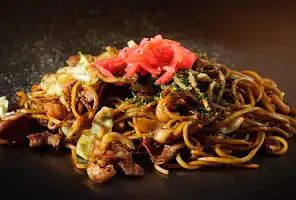







February 24, 2024
I was blown away by this Wagyu beef dish! The beef's tenderness combined with the sweet and savory sauce is heavenly. The ginger touch is just right. It's surprisingly easy to make and tastes like it's straight from a high-end restaurant.